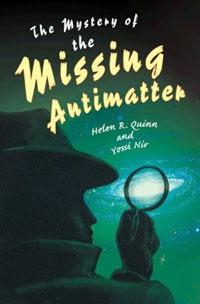|
|
Review: The Mystery of the Missing Antimatter
by Jeff Foust
Monday, March 10, 2008
The Mystery of the Missing Antimatter
By Helen R. Quinn and Yossi Nir
Princeton Univ. Press, 2008
hardcover, 292 pp., illus.
ISBN 978-0-691-13309-6
US$29.95
It’s ironic that particle physics is often closely linked to cosmology. The two fields are at the opposite extremes of scale, with particle physics focused on the subatomic realm while cosmology deals with the entire universe. (One thing they do have in common is that they deal with scales that often boggle the human mind and defy conventional wisdom.) Yet, as it turns out, some of the biggest questions in cosmology—why the universe is structured the way it is—are linked to the physics that governs the array of exotic particles and forces within the atom. One of these questions is accessibly addressed in the new book The Mystery of the Missing Antimatter.
Physicists Helen R. Quinn and Yossi Nir write that cosmology today has three major questions: the nature of dark matter, the nature of dark energy, and why matter dominates over antimatter in the universe. As the book’s title suggests, they focus on the third question: if antimatter is, from a physics standpoint, the mirror image of matter, why is there so little antimatter in the universe? What happened early in the universe’s history to favor—if by only a small amount—the creation of matter instead of antimatter?
| What happened early in the universe’s history to favor—if by only a small amount—the creation of matter instead of antimatter? |
The authors use that mystery to take the reader on a guided tour of particle physics from the early 20th century through the present, as the field exploded with the discovery an exotic zoo of particles and theorists worked to explain how all these particles fit together in an overarching model. While physicists have taken great strides in this field, some questions—like the mystery posed in the book’s title—remain unanswered, although not for lack of effort.
Particle physics has, like other scientific fields, its own lexicon that can be baffling to outsiders, and while reading The Mystery of the Missing Antimatter one runs the risk of getting lost among terms like CP violation, J/psi particles, and leptogenesis. The authors do their best, though, to explain non-intuitive physics with plain language and analogies. (The authors write in the first person plural—“we are convinced” and “our book”, for example—with occasional, usually biographical, asides attributed to one of the authors; this is a little unusual but overall not that distracting from the flow of the text.) For those curious about why the universe is the way it is, this book is a reminder of how much we have learned about physics at its smallest and largest scales, but also how much more we have yet to understand.
Jeff Foust (jeff@thespacereview.com) is the editor and publisher of The Space Review. He also operates the Spacetoday.net web site and the Space Politics and Personal Spaceflight weblogs. Views and opinions expressed in this article are those of the author alone, and do not represent the official positions of any organization or company, including the Futron Corporation, the author’s employer.
|
|
